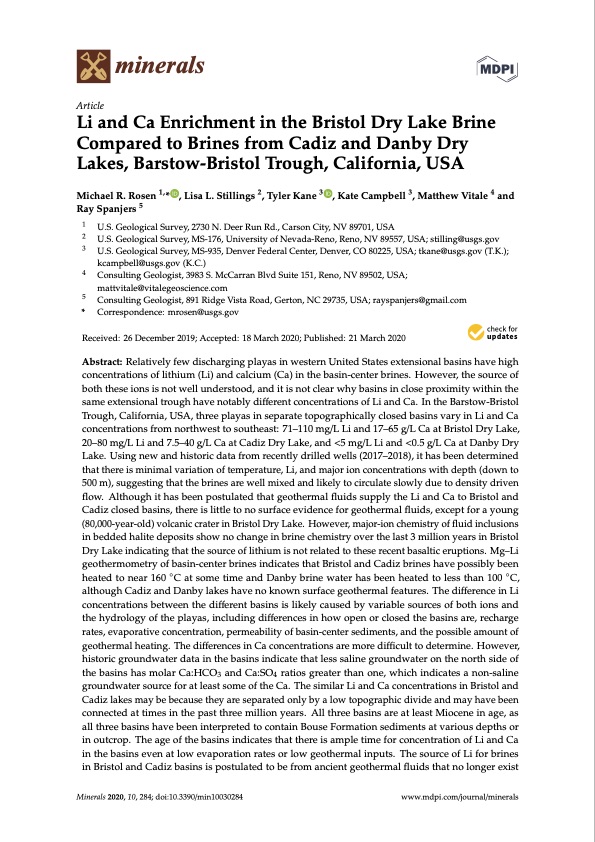
PDF Publication Title:
Text from PDF Page: 001
minerals Article Li and Ca Enrichment in the Bristol Dry Lake Brine Compared to Brines from Cadiz and Danby Dry Lakes, Barstow-Bristol Trough, California, USA Michael R. Rosen 1,* , Lisa L. Stillings 2, Tyler Kane 3 , Kate Campbell 3, Matthew Vitale 4 and Ray Spanjers 5 1 2 3 4 5 * Correspondence: mrosen@usgs.gov Received: 26 December 2019; Accepted: 18 March 2020; Published: 21 March 2020 U.S. Geological Survey, 2730 N. Deer Run Rd., Carson City, NV 89701, USA U.S. Geological Survey, MS-176, University of Nevada-Reno, Reno, NV 89557, USA; stilling@usgs.gov U.S. Geological Survey, MS-935, Denver Federal Center, Denver, CO 80225, USA; tkane@usgs.gov (T.K.); kcampbell@usgs.gov (K.C.) Consulting Geologist, 3983 S. McCarran Blvd Suite 151, Reno, NV 89502, USA; mattvitale@vitalegeoscience.com Consulting Geologist, 891 Ridge Vista Road, Gerton, NC 29735, USA; rayspanjers@gmail.com Abstract: Relatively few discharging playas in western United States extensional basins have high concentrations of lithium (Li) and calcium (Ca) in the basin-center brines. However, the source of both these ions is not well understood, and it is not clear why basins in close proximity within the same extensional trough have notably different concentrations of Li and Ca. In the Barstow-Bristol Trough, California, USA, three playas in separate topographically closed basins vary in Li and Ca concentrations from northwest to southeast: 71–110 mg/L Li and 17–65 g/L Ca at Bristol Dry Lake, 20–80 mg/L Li and 7.5–40 g/L Ca at Cadiz Dry Lake, and <5 mg/L Li and <0.5 g/L Ca at Danby Dry Lake. Using new and historic data from recently drilled wells (2017–2018), it has been determined that there is minimal variation of temperature, Li, and major ion concentrations with depth (down to 500 m), suggesting that the brines are well mixed and likely to circulate slowly due to density driven flow. Although it has been postulated that geothermal fluids supply the Li and Ca to Bristol and Cadiz closed basins, there is little to no surface evidence for geothermal fluids, except for a young (80,000-year-old) volcanic crater in Bristol Dry Lake. However, major-ion chemistry of fluid inclusions in bedded halite deposits show no change in brine chemistry over the last 3 million years in Bristol Dry Lake indicating that the source of lithium is not related to these recent basaltic eruptions. Mg–Li geothermometry of basin-center brines indicates that Bristol and Cadiz brines have possibly been heated to near 160 ◦C at some time and Danby brine water has been heated to less than 100 ◦C, although Cadiz and Danby lakes have no known surface geothermal features. The difference in Li concentrations between the different basins is likely caused by variable sources of both ions and the hydrology of the playas, including differences in how open or closed the basins are, recharge rates, evaporative concentration, permeability of basin-center sediments, and the possible amount of geothermal heating. The differences in Ca concentrations are more difficult to determine. However, historic groundwater data in the basins indicate that less saline groundwater on the north side of the basins has molar Ca:HCO3 and Ca:SO4 ratios greater than one, which indicates a non-saline groundwater source for at least some of the Ca. The similar Li and Ca concentrations in Bristol and Cadiz lakes may be because they are separated only by a low topographic divide and may have been connected at times in the past three million years. All three basins are at least Miocene in age, as all three basins have been interpreted to contain Bouse Formation sediments at various depths or in outcrop. The age of the basins indicates that there is ample time for concentration of Li and Ca in the basins even at low evaporation rates or low geothermal inputs. The source of Li for brines in Bristol and Cadiz basins is postulated to be from ancient geothermal fluids that no longer exist Minerals 2020, 10, 284; doi:10.3390/min10030284 www.mdpi.com/journal/minerals PDF Image | Bristol Dry Lake Brine Compared to Brines from Cadiz

PDF Search Title:
Bristol Dry Lake Brine Compared to Brines from CadizOriginal File Name Searched:
minerals-10-00284-v2.pdfDIY PDF Search: Google It | Yahoo | Bing
Product and Development Focus for Infinity Turbine
ORC Waste Heat Turbine and ORC System Build Plans: All turbine plans are $10,000 each. This allows you to build a system and then consider licensing for production after you have completed and tested a unit.Redox Flow Battery Technology: With the advent of the new USA tax credits for producing and selling batteries ($35/kW) we are focussing on a simple flow battery using shipping containers as the modular electrolyte storage units with tax credits up to $140,000 per system. Our main focus is on the salt battery. This battery can be used for both thermal and electrical storage applications. We call it the Cogeneration Battery or Cogen Battery. One project is converting salt (brine) based water conditioners to simultaneously produce power. In addition, there are many opportunities to extract Lithium from brine (salt lakes, groundwater, and producer water).Salt water or brine are huge sources for lithium. Most of the worlds lithium is acquired from a brine source. It's even in seawater in a low concentration. Brine is also a byproduct of huge powerplants, which can now use that as an electrolyte and a huge flow battery (which allows storage at the source).We welcome any business and equipment inquiries, as well as licensing our turbines for manufacturing.| CONTACT TEL: 608-238-6001 Email: greg@infinityturbine.com | RSS | AMP |